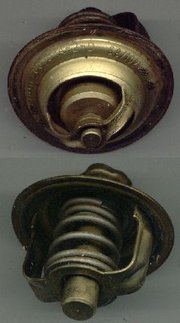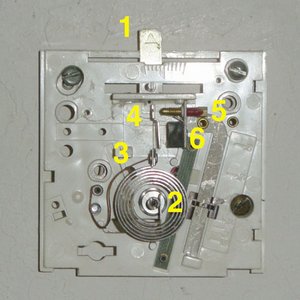Thermostat
A thermostat is a device for maintaining the temperature of a system within a range by controlling, either directly or indirectly, the flow of heat energy into or out of the system.
Mechanical
Bi-metal
On a steam or hot-water radiator system, the thermostat may be an entirely mechanical device incorporating a bi-metal strip. Generally, this is an automatic valve which regulates the flow based on the temperature. For the most part, their use is now rare, as modern under-floor radiator systems use electric valves, as do some older retrofitted systems.
Mechanical thermostats are used to regulate dampers in rooftop turbine vents, reducing building heat loss in cool or cold periods.
An automobile passenger compartment's heating system has a thermostatically controlled valve to regulate the water flow and temperature to an adjustable level. In older vehicles the thermostat controls the application of engine vacuum to actuators that control water valves and flappers to direct the flow of air. In modern vehicles, the vacuum actuators may be operated by small solenoids under the control of a central computer.
Wax pellet

In automobiles with an internal combustion engine a thermostat is part of the engine's cooling system. A water pump will pump water from the radiator through the engine block and cylinder head to cool it. A thermostat controls the flow of hot water from the block back to the radiator. In this type of thermostat, rather than using a bi-metal device, a wax pellet, solid at low temperatures, is confined in a sealed chamber. Wax expands when it is heated and becomes liquid. The chamber has an expansion provision that operates a rod that in turn operates a valve. This valve opens when the operating temperature is exceeded. The operating temperature is fixed, but is determined by the specific composition of the wax, so thermostats of this type are available to maintain different temperatures, typically in the range of 70 to 90 °C (160 to 200 °F). Modern engines are run hot, over 80 °C (180 °F), to run more efficient and to reduce emission of pollutants. The thermostat will also have a small bypass hole so that some hot fluid may reach the mechanism, which is on the cold side of the valve. Modern cooling systems contain a spring loaded pressure cap and an external fluid reservoir. Owing to the high temperature, the cooling system will become pressurized to the extent permitted by the relief. The additional pressure increases the boiling point of the fluid above that at atmospheric pressure — for water, 100 °C (212 °F).
The antifreeze (coolant) is a mixture of water and (historically) ethylene glycol, which will raise the boiling point, as well as provide lubrication to the water pump seals and bearings, has corrosion inhibitor properties to protect the engine block, pump, radiator, and heater, and lowers the freezing temperature.
Electrical
Simple Two Wire Thermostats

The illustration is the interior of a common two wire heat-only household thermostat, used to regulate a gas-fired heater via an electric gas valve. The power for this valve is provided by a thermocouple heated by a pilot light (a small, constantly-burning flame) that also provides the ignition for the main burner.
- Set point control lever. This is moved to the right for a higher temperature. the round indicator pin in the center of the second slot shows through a numbered slot in the outer case.
- Bi-metal coil. The center of the coil is attached to a rotating post attached to lever (1). As the coil gets colder the moving end - carrying (4) - moves clockwise.
- Flexible wire. The left side is connected via one wire of a pair to the heater control valve.
- Moving contact attached to the bi-metal coil.
- Fixed contact screw. This is adjusted by the manufacturer. It is connected electrically to the other wire to the thermocouple and thence to the heater control valve.
- Magnet. This ensures a good contact when the contact closes, and also prevents short heating cycles, as the temperature must be raised several degrees before the contacts will open.
As an alternative, some thermostats instead use a mercury switch on the end of the bi-metal coil. The weight of the mercury on the end of the coil tends to keep it there, also preventing short heating cycles. However, this type of thermostat is banned in many countries due to their highly and permanently toxic nature if broken. When replacing these thermostats they must be regarded as chemical waste.
- (not shown) - a separate bi-metal thermometer on the outer case indicates the actual temperature at the thermostat.
Troubleshooting
Owing to the weak current available from a thermocouple this system is sensitive to adjustment and contact corrosion problems. A rare problem is a spider's nest on the contact point, preventing closure of the circuit. A far more common problem is a weak, failed, or poorly positioned (relative to the pilot light) thermocouple in the heater itself. Sometimes (but rarely) the main burner operating valve will fail. A more dangerous but less common failure is when a small particle of detrius or other defect causes the main valve to incompletely seal the flow of gas. This the resultant low flow of gas is insufficient to allow ignition of the main burner but can cause a buildup of gas, a potentially dangerous and explosive condition. Valves exhibiting this defect in any heater or clothes drier, or other natural gas or propane fueled appliance should be replaced immediately by a qualified technician.
Line voltage thermostats
The setup described above is also typical for all-electric heat, whether baseboard or centralised. Since there is no pilot light in an electric system, there is no thermocouple to provide power. In such cases, the thermostat may use either full line voltage (in the United States, 120 or 240 volts) or lower voltage (typically 20-30 volts) provided using a transformer. If a line voltage thermostat is used, system power is directly switched by the thermostat. If a low voltage thermostat is used, a relay must be used to switch the system on and off. Using a low voltage thermostat on a line voltage circuit will result at least in the failure of the thermostat and possibly a fire. Line voltage thermostats are sometimes used in other applications such as the control of fan-coil units in large systems using centralized boilers and chillers.
Combination Heating/Cooling Regulation
Depending on what is being controlled, a forced-air air conditioning thermostat generally has an external switch for heat/off/cool, and another on/auto to turn the blower fan on constantly or only when heating and cooling are running. Four wires come to the thermostat from the main unit (usually located in a closet, basement, or occasionally attic): one 24-volt for power, one for heat, one for cool, and one for fan. The power is supplied by a transformer, and when the thermostat makes contact between power and another wire, a relay back at the main unit activates that part of the unit.
Heat Pump Regulation
In the case of a heat pump, which reverses the air conditioning in winter to provide heat, a second contact is usually provided for "emergency" heat – a backup of electrical heating elements which run when the temperature falls too far (usually about 1°C or 2°F) below the main setting. (These coils also run when the unit is in defrost mode, though this is controlled by the outdoor unit rather than the indoor thermostat.) There is also a slight difference in the wiring, as instead of "heat" and "cool" wires, there is one to turn on the outdoor compressor unit, and another to hold the reversing valve for cooling in summer and defrosting in winter.
Digital
Newer digital thermostats have no moving parts, and instead rely on thermistors to measure the temperature. Typically one or more regular batteries must be installed to operate it, as electrical current is not flowing when nothing is running, and there is no separate low-voltage power wire supplied from the main unit. Each has an LCD screen showing the current temperature, and the current setting. Most also have a clock, and time-of-day (and now day-of-week) settings for the temperature, used for comfort and energy conservation. Some now even have touch screens, or have the ability to work with X10 or other home automation systems.
Most of these have been designed to work on standard 24-volt systems, however some deluxe units now have millivolt systems, whereby only analog or digital signals are sent along the lines, rather than using electromechanical means.
